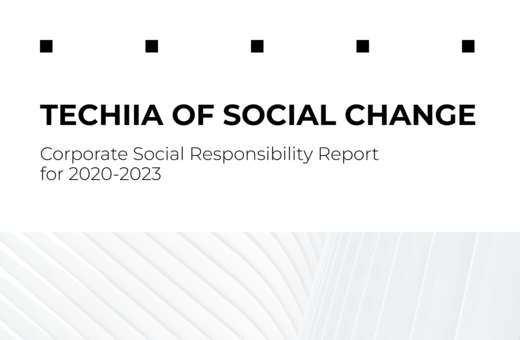
Architects and developers are seeking a way to get rid of visible supports in glass structures to improve the aesthetics of the building without compromising its functionality. The technology developed by the Aestech team not only solves this problem, but can also improve the environmental situation.
eople care about the environment. Over 200 years have passed since the Industrial Revolution, when mass production was more important than air quality and human health. Today, we want to live in a safe and clean world and know that our children will grow up in good conditions.
Let's take a look at a few examples to find out how to make it happen.
Reducing emissions through urban planning
In 2016, the UN launched a , a lengthy political dicument aimed at motivating states to introduce environmental legislation. Despite its utopian wording, it articulates that the signatories are committed to protecting ecosystems and biodiversity, and encouraging citizens to live in harmony with nature.
Transport, waste minimization and recycling, biodegradable packaging, and emission filters at enterprises are obvious areas for improving the environmental situation.
In Denmark, for example, they started with cars wich were limited in their right to space. Ian Gale, in his book "Cities for People" writes that according to scientists’ calculations, two 7-meter-wide sidewalks allow 20,000 people to pass through per hour, while two bicycle paths, each 2 meters wide, can accommodate 10,000 cyclists per hour. As for cars, a two-lane, two-way road at peak times, can accommodate from 1,000 to 2,000 cars.
By the criterion of capacity, roads lose out. At least in the city center. As for parking lots, 10 bicycles can easily fit in one car space. Checkmate. They increased the capacity of the streets, managed the area wisely, and at the same time implemented part of the UN’s environmental program.
Another example is the United States, a country of great distances and car travel. But even there, certain sections of major roads are turned into pedestrian zones. That's what was done in San Francisco. After the , the damaged Embarcadero highway was not restored to full automobile use. Now there is a pedestrian zone, a trolleybus line, palm trees along the walkways. In other words, they made the air cleaner by reducing the car load.
But there are other points of effort. On the one hand, they are obvious, and on the other hand, we see them every day and do not even realize that we can take a big step towards a healthy environment.
Obvious yet not so obvious aluminum
Our cities are increasingly filled with buildings featuring glass facades, terraces, and atriums. At the same time, they are glass only at first glance. The sheets of translucent enclosing structures are often "cut" with metal supports, pillars, and bars. These elements allow standard double-glazed windows with which the building is sheathed, to withstand wind and rain loads.

The metal used to create these supporting profiles is most often aluminum. It poses a risk to the environment and sustainable development, an issue that is oven overlooked.
At the time of writing this article, the of a ton of aluminum was $2653. The highest price was recorded in March 2022 at $3849. The demand for this metal will increase, and so will its price. The aluminum market will by 2.6% annually, and by 2029 it is expected to reach 78.4 million tons. According to , the price of the metal will rise to $3,500 per ton by 2025.
As for the environment, let's start with the fact that the production of aluminum is an energy-intensive and toxic process. The average energy consumption for the production of one ton is 14 MWh. Only indirect emissions from electricity production account for 70% of the total emissions from aluminum production which are harmful to human health and safety of the environment.
The Agency for Toxic Substances and Disease Registry, which is oprated by the US Department of Health, lung problems in those who, due to work or other circumstances, inhale significant amounts of aluminum dust. In some cases, excessive contact with aluminum leads to bone or even brain disease.
Some studies show that excessive exposure to aluminum leads to decreased productivity, and some scientists have consistently proved a link between excessive amounts of aluminum in the body and the development of Alzheimer's, dementia, epilepsy, and autism.
Aluminum is also hazardous to aquatic environment. Freshwater algae, designed to maintain the bioavailability of dissolved oxygen, lose their properties. Inhabitants of water bodies, which breath with gills, and invertebrates lose osmoregulation. Eventually, infected aquatic animals can become part of the human food chain.
In conclusion, aluminum is an expensive and harmful in excessive doses metal which is used for the production of supporting profiles for enclosing translucent structures. But the from Aestech engineers allows you to ged rid of this metal.
Getting rid of excess metal in buildings
To remove metal supports from the glass facade, it is necessary to come up with a way to transfer the load-bearing function to the glass unit itself. And we came up with a solution.
In a standard glass unit, the glass layers are connected by a soft secondary sealant. Due to this, the glasses do not interact with each other much, and all the load falls on the outer layer of glass.
We replaced the secondary sealant with a rigid pultruded frame and high-adhesion glue. This has allowed us to combine layers of glass into a monolithic structure — an insulated glass unit with higher stiffness. It is up to 10 times stiffer than a regular glass unit. This means that it can withstand both its own weight and wind loads without external supports. In addition, fasteners can be screwed directly into the frame of the glass unit and attach it to the supporting structures of the building.

The solution opens many at once. There is no need to purchase aluminum profiles, arrange delivery and installation. A frame is not necessary, so the glazing of a multi-story building can start from the first floor. The energy efficiency of the translucent structure and sound insulation are also improved, as metal profiles are conductors of cold / heat and sound.
The more developers abandon old technologies in favor of new ones, the less the demand there will be for aluminum. Less demand means less production and less harmful impact on the residents of industrial towns and the environment. mean less electricity consumption for heating or cooling, and fewer emissions from power plants.
This is our answer to the question of how countries can further improve the environmental situation with one solution. In addition, frameless glazing technologies have ergonomic and aesthetic advantages, which we .
Source:


